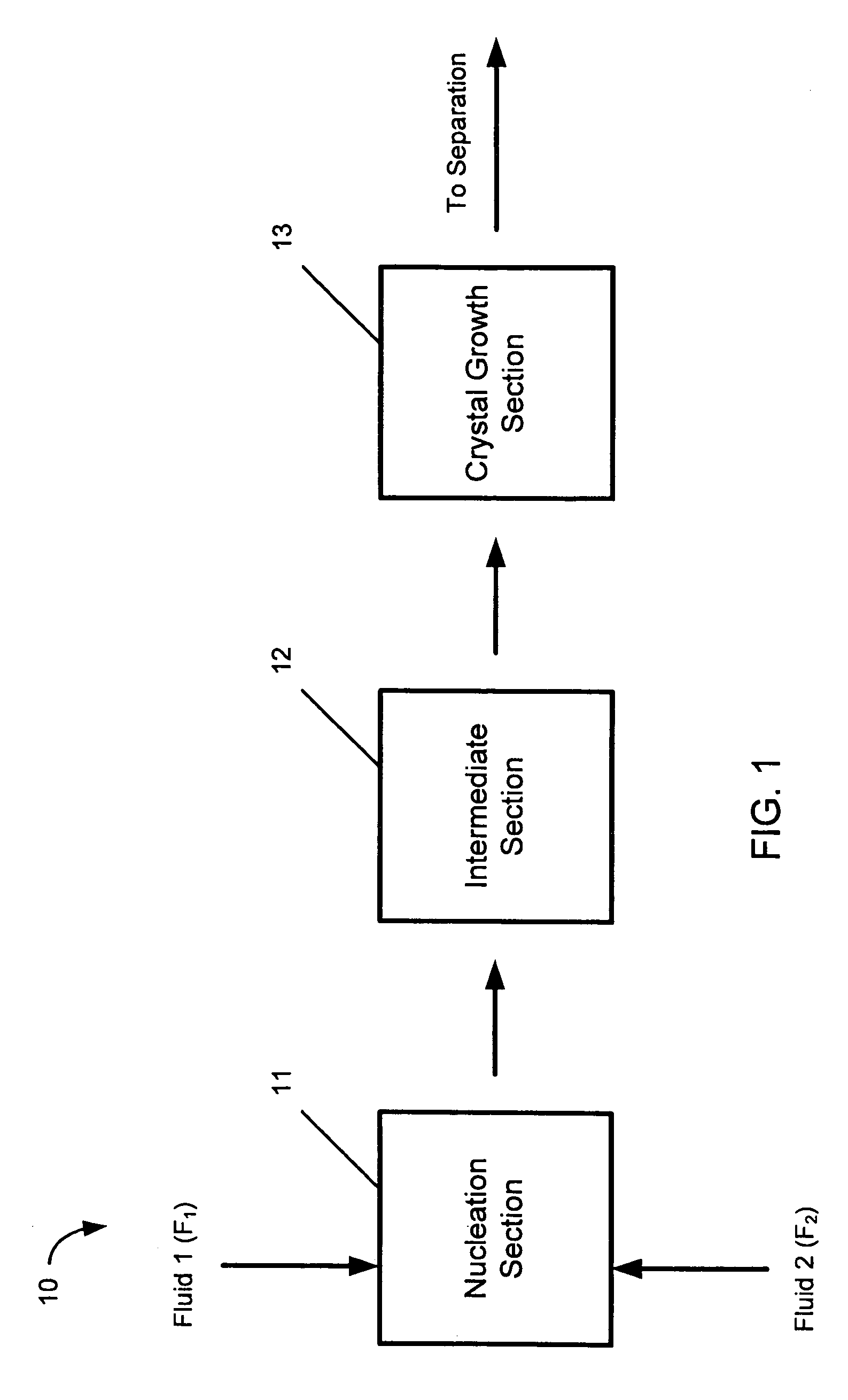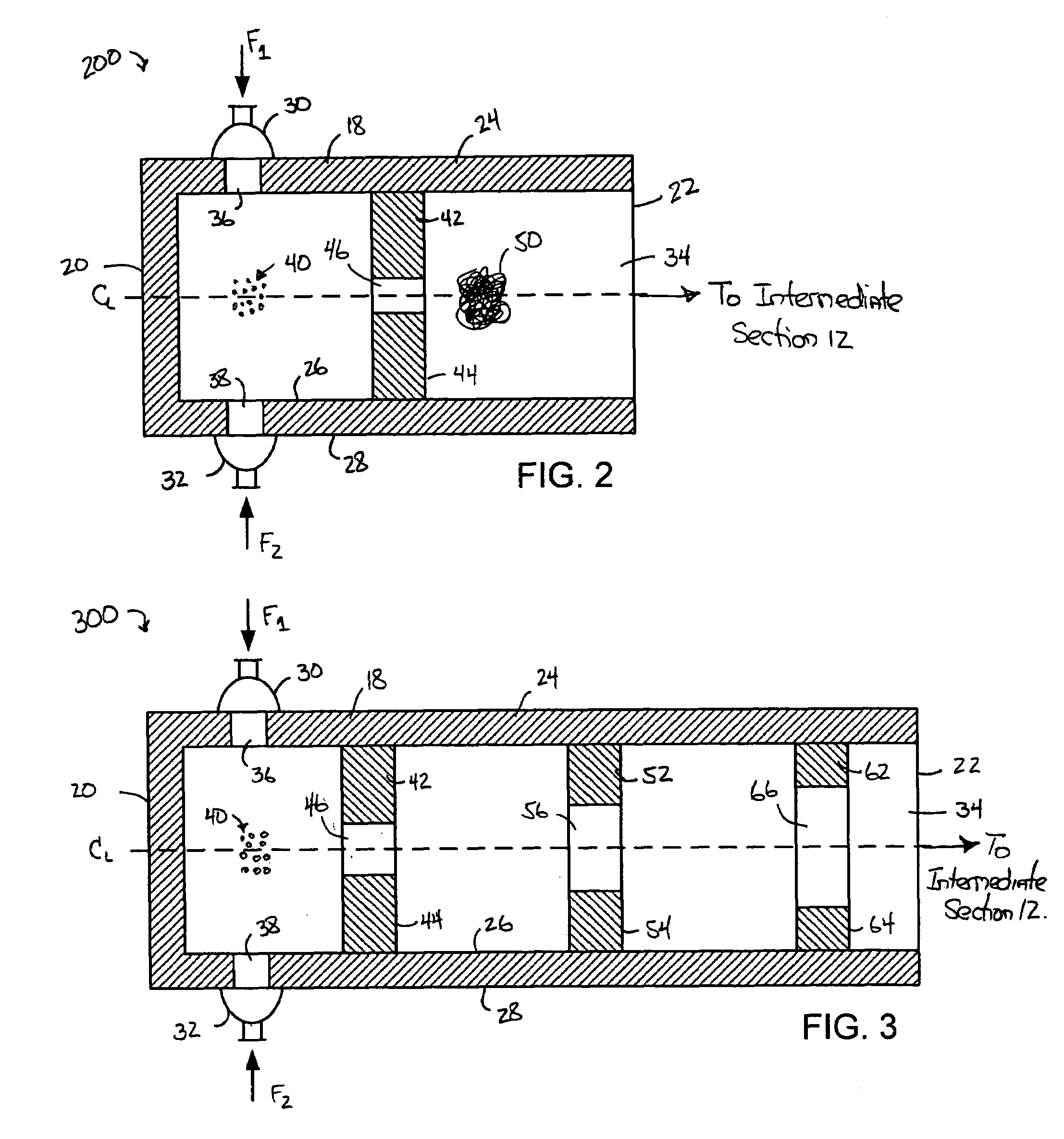Hydrodynamic cavitation crystallization device and process
a technology of hydrodynamic cavitation and crystallization device, which is applied in the direction of crystal growth process, separation process, drug composition, etc., can solve the problems of batch crystallization suffering from quality control issues, requiring significant time and money between batches, and allowing adequate quality control
- Summary
- Abstract
- Description
- Claims
- Application Information
AI Technical Summary
Benefits of technology
Problems solved by technology
Method used
Image
Examples
example 1
[0072]Three p-acteylaminophenol (acetaminophen) solutions are prepared as follows: 23.888 grams of p-acteylaminophenol is added to 100 grams of 30:70 by weight water / EtOH solution. The crystallization process is carried out in the device of FIG. 12 where F1, F3, and F4 are anti-solvent fluid streams and F2 is a feed solution. The anti-solvent is water and is added via F1, F3, and F4 to yield a final volume ratio of anti-solvent to feed solution of 70:30 when mixed fluid stream Fm exits the nucleating section of device 1200. No additional heating, cooling or pH modification is conducted in intermediate section 802.
[0073]In the crystal growth section 900 of device 1200, mixed fluid stream Fm is re-circulated via a high pressure pump through a hydrodynamic cavitation crystallization sub-section 910 containing cavitation generator 920.
[0074]The pressure of pump 906 is varied according to Table 1 and the re-circulation time is held constant at 5 minutes. At the end of the re-circulation ...
example 2
[0076]Two p-acteylaminophenol (acetaminophen) solutions are prepared as follows: 23.888 grams of p-acteylaminophenol is added to 100 grams of 30:70 by weight water / EtOH solution. The crystallization process is carried out in the device of FIG. 12 where F1, F3, and F4 are anti-solvent fluid streams and F2 is a feed solution. The anti-solvent is water and is added via F1, F3, and F4 to yield a final volume ratio of anti-solvent to feed solution of 70:30 when mixed fluid stream Fm exits the nucleating section of device 1200. No additional heating, cooling or pH modification is conducted in intermediate section 802.
[0077]In the crystal growth section 900 of device 1200, mixed fluid stream Fm is re-circulated via a high pressure pump through a hydrodynamic cavitation crystallization sub-section 910 containing cavitation generator 920.
[0078]The pressure of pump 906 is varied according to Table 2 and the re-circulation time is held constant at 15 minutes. At the end of the re-circulation t...
example 3
[0080]Two p-acteylaminophenol (acetaminophen) solutions are prepared as follows: 23.888 grams of p-acteylaminophenol is added to 100 grams of 30:70 by weight water / EtOH solution. The crystallization process is carried out in the device of FIG. 12 where F1, F3, and F4 are anti-solvent fluid streams and F2 is a feed solution. The anti-solvent is water and is added via F1, F3, and F4 to yield a final volume ratio of anti-solvent to feed solution of 70:30 when mixed fluid stream Fm exits the nucleating section of device 1200. No additional heating, cooling or pH modification is conducted in intermediate section 802.
[0081]In the crystal growth section 900 of device 1200, mixed fluid stream Fm is re-circulated via a high pressure pump through a hydrodynamic cavitation crystallization sub-section 910 containing cavitation generator 920.
[0082]The pressure of pump 906 is varied according to Table 3 and the re-circulation time is held constant at 30 minutes. At the end of the re-circulation t...
PUM
| Property | Measurement | Unit |
|---|---|---|
| weight | aaaaa | aaaaa |
| pressure | aaaaa | aaaaa |
| weight | aaaaa | aaaaa |
Abstract
Description
Claims
Application Information
 Login to View More
Login to View More - R&D
- Intellectual Property
- Life Sciences
- Materials
- Tech Scout
- Unparalleled Data Quality
- Higher Quality Content
- 60% Fewer Hallucinations
Browse by: Latest US Patents, China's latest patents, Technical Efficacy Thesaurus, Application Domain, Technology Topic, Popular Technical Reports.
© 2025 PatSnap. All rights reserved.Legal|Privacy policy|Modern Slavery Act Transparency Statement|Sitemap|About US| Contact US: help@patsnap.com



